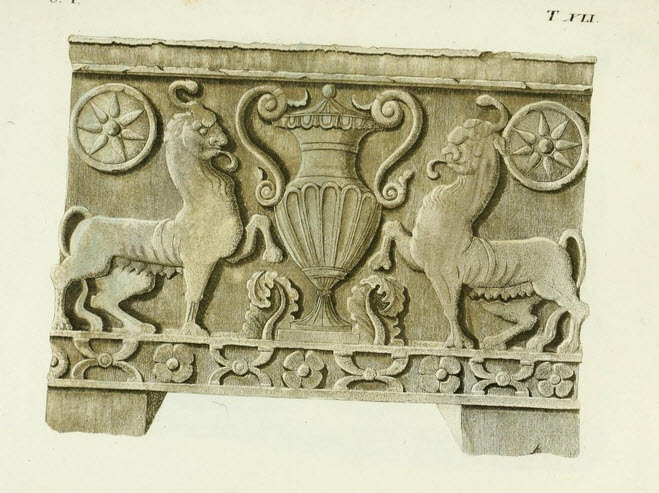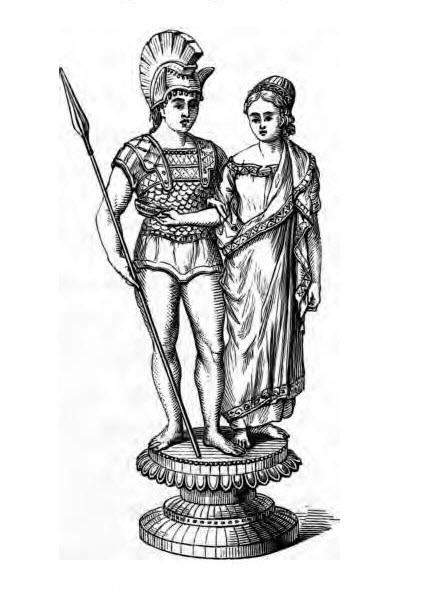
Scene from an Etruscan Tomb. What Little We Know of the Etruscan Language Comes Mainly From Funerary Inscriptions
The Etruscans had an extensive literature. The subjects represented on the monuments prove their familiarity with the tale of Troy and the cycle of Greek heroic legend, and we learn that they possessed histories, poems, dramas, and works on augury and divination. But their books have perished, so that in addition to a few doubtful Etruscan words preserved by Hesvchius, Varro, and other writers, our knowledge of the language is derived only from inscriptions, of which about 5000 have been discovered. To the meaning of these we have unfortunately no clue, as the few bilinguals consist mainly of proper names. They wrote from right to left, in an archaic form of the Italic alphabet, which was obtained from Euboea about the 7th century B.C. The Etruscan alphabet differs from the Latin in retaining the letters theta, phi, chi, and san, and in rejecting d, b,g, and o.

Scene from an Etruscan Tomb. What Little We Know of the Etruscan Language Comes Mainly From Funerary Inscriptions
Most of the inscriptions are very short, only five containing more than twenty words. The longest, that on the Perugian cippus, extends to forty six lines. They have been found as far north as the Alps, near Nice, Turin, and the lakes of Como and Lugano. But they mostly come from five or six sites in Central Etruria, one fourth of the whole number being from Chiusi, and one third from Perugia. Some vast cemeteries, such as those of Veii and Bologna, have yielded few or none, possibly because they date from a time when the art of writing had not become general.
About 4000 of the inscriptions are short mortuary records, stating usually the name and parentage of the deceased; his age, his condition in life, and the public offices he held being occasionally added. They occur on the walls or over the entrances of vaults, on steles or pillars erected in front of tombs, or on the labels and seals of sepulchral niches, but they are more usually painted on the urns, or cut in the stone of the sarcophagi, a recumbent figure of the deceased frequently reposing on the lid, while the sides are sculptured with mythological subjects or scenes from the life of the deceased.
Working with such materials, German and English scholars have recently made considerable progress in the decipherment of the language, so that most of the short mortuary inscriptions can now be read with tolerable certainty. The inscriptions contain some 200 Etruscan words in addition to the proper names. Of these names a few, such as Care (Gaius), Cneve (Gnaevus), Marce (Marcus), and Tite (Titus), are borrowed from neighbouring or subject races. Of genuine Etruscan names the most usual for men are Arnth (Aruns), Aule (Aulus), Larth (Lars), Sethre, Vele, Velthur, and Vete; and for women, Arnthia, Aulia, Larthia, Sethria, Fastia, Ramtha. Thania, and Thancvil. Many Roman gentile names, such as Spurinna and Perpenna, were of Etruscan origin, while Pompeius, Petronius, Cafatius, Cassius, Caecina, Volumnius, and Afinius appear in Etruscan tombs as Pumpu, Petruni, Cahate, Cazni, Ceicna, Velimna, and Afuna.
A few Etruscan names have been explained. Thus, Thancvil (Tanaquil) was the wife of Tarquinius Priscus. Thana must have been the Etruscan goddess of maternity (= Juno Luciua), as on a mirror she assists at the birth of Minerva, and cvil (or cver) denotes "gift " or "dedication," the word Tinscvil being inscribed on objects dedicated to Tinia (Jupiter). Hence Thancvil would mean "Thiana's gift," and may be compared with such Christian names as Theodore or Diodorus. Again, Spurie, an Etruscan name, seems to be equivalent to the Latin Publius. The words spural and spurana, inscribed on vessels, armour, and tombs, signify that they were "civic" or "public" property; and the phrase amce marunuch spurana, in an epitaph, probably means "fuit curator publicus."
Relationship is sometimes expressed by words, such as puia, "wife;" clan, "son; sec, "daughter;" but more commonly by suffixes. Thus, Aulesa is the "wife of Aule," Theprisa the "wife of the Thepri" (Tiberius), Larthial the "son of Larthia," Larthialisa the "wife of Larthia"s son." Velthur is a "descendant of Vele," and Velthurithura a "descendant of Velthur." Gentile names are formed by the suffix na, corresponding to the Latin ius. Thus, Vipna is the equivalent of Vibius, Varna of Varius, Caizna of Caesius. This suffix is a common formative. Thus suthi, "sepul-crum,' gives sutnina, "sepulcralis." The suffix "l" or "al" has a similar force, for example fuflunsl, "a Bacchic cup," from Fufluns, "Bacchus; " and Truial, "a Trojan," from Truia, "Troy." Other ethnic formatives are ach and cite, as Rumach, "a Roman," and Manthvate, "a Mantuan."
Six words inscribed on the faces of a pair of dice give the first six digits, and other numerals appear in records of age which occur in epitaphs. The words mach, ci, zed, sa, thu, huth, semph, cezp, muv are believed to be the digits, while ce-alcl, cezp-alchl, semph-alchl, muv-alchl, zathrum, and dem-zathrum must be decades. Ordinals and multipli-catives are formed from the cardinals. Thus ci, "two," gives ci-s, "second," and ci-zi, twice.
The detection of the numerals has made it possible to show that the plural ends in r or l. Thus, clan (son) gives clen-ar, "sons; " as ci clenar, "two sons," and clenar zal, "three sons." The phrases huth naper, naper ci, naper xii., show that naper is a plural, meaning "loculi " or "tombs." The plural in -l also appears in arce ril lxvii., "habuit annos lxvti.," and in mursl xx. So tular signifies "cippi," and suthinesl "sepulchral niches." The names of men and women already cited, and such forms as lautni, "a freed man," and lautnitha, "a freed-woman," show that Etruscan was a gender language.

Etruscan Statuette
There seems to have been no distinction between nominative and accusative. The genitive ended in -s, the dative in -si or -thi; and, as in the Altaic languages, the plural suffix preceded that denoting the case. Thus, from clan, "son," we have gen. clen-s, dat. clen-si, nom. and acc. pl clen-ar, dat. pl. clen-ar-asi; while precuth-ur-asi is the dat. pl. of precus. From tiv, "moon " or "month," we have tiv-r, "menses," and tiv-r-s, "inensium;" from usil, "sol,' usils, "solis; " and from suthi, "sepulcrum," suthi-thi, "sepulcro." The suffixes -c and -m are enclitic conjunctions—thus, vel. sethre puiac is the epitaph of "Vele Sethre and wife," and arnth vipis serturis puiac mutainei that of "Arnth (son of) Vipi Serturi and (his) wife Mutainei." According to Dr Pauli, mi means "this,"or "this is;" while cehen, ora, or ecu means "here. " The meaning of several substantives, in addition to those already cited, has also been determined with tolerable certainty.
Coming to the verbs, am-ce certainly means "fuit,' while ma appears to be "est. " The 3d pers. sing, of the perfect tense ended in -ce, and of the present in. -e. We have tur-e, "dat; " tur-ce, "dedit;" ar-ce, "habuit;' tham-ce, "extruxit ' sval-ce, "obiit;" lupu-ce, "decessit." Thus, denar zal arce is "filios tres habuit," and ramtha matulnei sech marces matulnas puiam amce sethres ceisinies may be translated "Ramtha Matulnei was the daughter of Marce Metulna, and wife of Sethre Ceisinie." These examples may serve to show that the once apparently hopeless task of translating the Etruscan inscriptions is at last in a fair way of being accomplished.